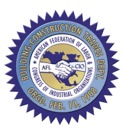The Best Value for Public Investment
Research over the last 30 years has repeatedly demonstrated that prevailing wage projects cost less, or no more overall, when all economic factors are evaluated. On average, labor costs account for a mere 20 percent of a project’s total cost, and prevailed projects are more likely to be completed on time, on budget, representing superior quality and with reduced injuries and fatality rates. The following studies document the benefits of prevailing wage policy.
The Most Recent Study:
The Effect of Prevailing Wage Regulations on Contractor Bid Participation and Behavior: A Comparison of Palo Alto, California with Four Nearby Prevailing Wage Municipalities This sample of bids by union and nonunion contractors on and off municipal pre- vailing wage projects in the San Francisco Bay area of California provides the first empirical evidence examining the effects of prevailing wage regulations on contractor participation and bidding behavior. The data show that the presence of prevailing wage regulations does not decrease the number of bidders nor alter the bidding behavior of contractors relative to the engineer’s estimate of the value of the project. Furthermore, in this heavily unionized area during an upswing in the business cycle, the presence of prevailing wage regulations did not discourage the participation of nonunion contractors nor reduce their chances of winning work.
The Benefits of State Prevailing Wage Laws: Better Jobs and More Productive Competition in the Construction Industry Report compares school construction costs before and after Michigan’s suspension of its prevailing wage law, which revealed no difference in total construction costs. Report also analyzes national data on school construction costs, which reveals that prevailing wage laws do not have a statistically significant impact on cost. By far, the biggest impact on school construction costs is whether that construction takes place at times of low unemployment, when construction demand and prices are high, or at times of higher unemployment.
An Analysis of Davis-Bacon Prevailing Wage Requirements: Evidence from Highway Resurfacing Projects in Colorado An “apples to apples” comparison of state and federal highway resurfacing projects in Colorado from 2000 to 3Q of 2010 shows there is no difference in project cost estimates between projects that do and those that do not require prevailing wages. Accounting for size, complexity, and removal of past work difference between state and federal projects explain the difference in cost estimates between projects. The notion that project costs rise when wages are increased is shown to be erroneous, because total project costs are in fact decreased due to increased worker productivity and efficiency by prevailing wage-scale workers.
Economic, Fiscal and Social Impacts of Prevailing Wage In San Jose, California Municipal building projects covered by a prevailing wage policy employ a higher proportion of local contractors and local workers. Prevailing wage laws therefore help reduce the leakage of local taxpayer dollars by directing public construction expenditures into the local economy. If prevailing wage coverage is removed from a municipal building project, then roughly 6% of the project’s value leaks from the Santa Clara County economy. If prevailing wage had not applied to San Jose’s 2007-2012 municipal building projects: Total economic activity in the County would have fallen by $164 million and 1,510 fewer local jobs would have been created in the County.
Prevailing Wages and Government Contract Costs: A Review of the Research A growing body of economic studies finds that prevailing wage regulations do not increase government contracting costs. These studies also show that prevailing wage laws provide social benefits from higher wages and better workplace safety, increase government revenues, and elevate worker skills in the construction industry.
Lessons for Post-Katrina Construction In the case of the Northridge earthquake, there were two benefits from hiring more skilled workers within Davis-Bacon rules. First, higher productivity per hour largely offsets any difference in labor cost per hour. Second, workers finish rebuilding more quickly.
An Evaluation of Prevailing Wage in Minnesota: Implementation, Comparability and Outcomes An analysis of Minnesota suggests that repealing or weakening the prevailing wage statute would cost the state between $37.8 and $178 million in tax revenues depending on which estimate of wage reduction one uses, and would result in weakening of apprenticeship training programs, an increase in injury rates, a weakening of the position of women and people of color in the construction industry, an increase in project cost overruns, and a reduction in construction employee wages.
The Economic Development Benefits of Prevailing Wage An extensive economics literature shows that prevailing wage in construction means more cost-effective construction, and more skilled and better-paid workers. Skilled construction workers who receive higher wages are about 20 percent more productive than less skilled workers. All else being equal, higher productivity means lower unit costs. Industrial development authorities exist to enhance local economic development.
The Economics of Prevailing Wage Laws This book is a collection of essays exclusively devoted to Prevailing Wages. The essays are by leading economists in the field, and cover a wide variety of topics and implications of using prevailing wages as a mechanism for stabilizing construction costs, and increasing value for project owners. Chapter 1 is available here.
Wages, Productivity and Highway Construction Costs, Updated Analysis A study of highways built from 1994 through 2002 showed that when workers’ skills and productivity justify higher wage rates, highways can be built at a lower cost per mile than when lower skilled workers are employed. High wage states showed a $30,000 per mile savings in construction costs compared to low-wage states.
The Adverse Economic Impact from Repeal of the Prevailing Wage Law in Missouri The repeal of the prevailing wage law would cost the residents of Missouri and their families between $294.4 million and $356.0 million annually in lost income. The repeal of the prevailing wage law would cost the State of Missouri between $5.7 million and $6.9 million in lost sales tax collections annually. The repeal of the prevailing wage law would cost the State of Missouri between $17.7 and $21.4 million annually in lost income tax revenue.
Analysis of Kentucky Governor’s Study “The Impact of Prevailing Wage Laws on Labor Costs for Capital Construction Projects” Analysis of Office of Kentucky State Budget Director report “The Impact of Prevailing Wage Laws on Labor Costs for Capital Construction Projects”. This analysis of that study shows it is flawed for a number of reasons, the three major ones being: Inappropriate use of Bureau of Labor Statistics wage data; Assumption of a one-for-one substitution of higher paid workers with lower paid workers; Assumption that in the absence of legislated rates, no above average rates would be paid. The authors conclude that the State’s report is a weak argument for eliminating prevailing wage laws in Kentucky.
Analysis of Regression and Surveys in Ohio LSC Report on S.B. 102 on Claimed Cost Savings from Exempting School Construction from Prevailing Wage Requirements Corrects earlier econometric analysis by the Ohio Legislative Service Commission claiming that SB102, which exempted public school construction from state-mandated prevailing wage regulations, saved $489M from date of implementation (August 1997) to the May 20, 2002 LSC Report. Author uses the same Dodge construction data and the same regression analysis techniques to show there is no statistical basis for any cost savings after the repeal of prevailing wage regulations.
Making Hay When It Rains: The Effect Prevailing Wage Regulations, Scale Economies, Seasonal, Cyclical And Local Business Patterns Have On School Construction Costs The authors examine and present estimates of the relative payoffs of alternative methods of reducing school construction costs - timing purchases, deregulating wages and building larger school facilities. While it is frequently speculated that a hot construction market is an expensive time to build large numbers of new schools, the study examines the economics as well as 10 years of actual data and statistics behind construction markets and school construction costs. The key findings of the study are: building without prevailing wages does not save on construction costs but that school districts building counter cyclically can enjoy a buyer's advantage during economic downturns. In addition, spacing out school construction projects so that many projects are not begun in the same period also promises significant savings to school districts.
Page Last Updated: Feb 14, 2013 (10:35:44)
|
|








